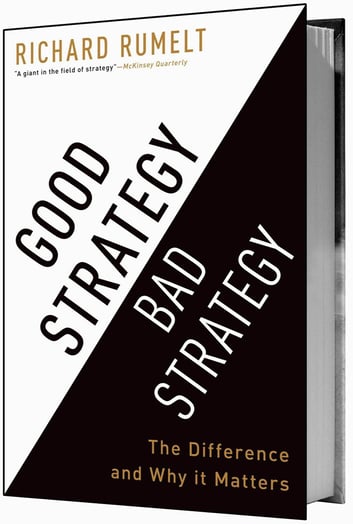 I’m in the midst of reading an excellent book at strategy. Good Strategy/Bad Strategy: The Difference and Why It Matters, by Richard Rumelt, should be consumed by any senior executive or advisor who is serious about business growth (h/t to David Cancel, Drift’s CEO for the recommendation). While some people may think a book published in 2011 is “old,” don’t let that scare you away. If anything it demonstrates that the fundamentals of good strategy are timeless.
I’m in the midst of reading an excellent book at strategy. Good Strategy/Bad Strategy: The Difference and Why It Matters, by Richard Rumelt, should be consumed by any senior executive or advisor who is serious about business growth (h/t to David Cancel, Drift’s CEO for the recommendation). While some people may think a book published in 2011 is “old,” don’t let that scare you away. If anything it demonstrates that the fundamentals of good strategy are timeless.
I have a friend who likes to say that the problem with most strategists is that they don’t know what strategy is. And there is probably no word used more frequently and improperly than strategy. If you bring more than a couple of business executives together to talk about their business, it’s virtually guaranteed that the term will be used more than any other word and that it will mean something different nearly every time it’s used.
In its essence, strategy is all about making choices, and choices are all about making decisions. The word “decide” and the word “homicide” both have the same Latin root and mean the same thing - to kill. When you decide, you “kill” the alternatives.
Strategy, therefore, is all about killing options. It’s about reducing chaos and confusion to increase the focus on fewer, critical elements. And, this is why strategy is so damn hard and so rarely used correctly or effectively. Killing options is hard and scary.
The 3 Most Common Mistakes Made With Strategy
Mistaking Fluff for Strategy
Our strategy is to implement a low-cost methodology to disrupt the status quo and to become the premier option in our category.
We will take a customer-centric approach to disintermediate our competitors.
Utilizing machine learning, we will create a first mover advantage.
I have no idea what any of these things mean, but I hear things like this all the time when senior executives and entrepreneurs talk about their “strategy.”
Here’s the thing about good strategy - it’s simple.
Mistaking Goals & Objectives For Strategy
Jack Welch, GE’s famous CEO, loved (and probably still loves) saying, “Reach for what appears impossible.” Jim Collins, in his book Good to Great, shared the importance of BHAGs (Big, Hairy Audacious Goals). And, of course, Yoda shared, “Try not. Do or do not, for there is no try.”
All of these are great for motivation. None of these are strategic.
Your strategy is not:
-
Reduce costs by 10%
-
Grow 20% per year
-
Be the leader of [fill in the blank]
The Failure to Commit - Fully - to the Strategy
Vision is not strategy. (It’s not even a required part of strategy.) Vision can be inspiring, but if you don’t generate and maniacally execute a strategy to achieve the vision, then it’s just entertainment. I’ve learned that people are great at putting one foot firmly into the new world described by the vision; they’re just not so good at taking the other foot out.
To this point, I’ve given some example of what strategy isn’t (or better stated, what bad strategy is). Let’s pause here and look at the elements of good strategy (at least as defined by Rumelt).
There are three elements to a good strategy:
-
A strong Diagnosis that clearly defines the challenge.
-
A Guiding Policy that, like the guardrails on a highway, directs and constrains action in certain directions without defining exactly what shall be done.
-
A set of Coherent Actions that dictate how the guiding policy will be carried out. The actions should be coherent, meaning the use of resources, policies, and maneuvers that are undertaken should be coordinated and support each other.
Committing to these actions does not mean you won’t revisit, adjust or completely alter the strategy in the future. To the contrary, a strong strategy is built to be dynamic and to allow learning and experience to naturally evolve the strategy.
However, the failure to commit to the strategy, the failure to plant both feet firmly focused on the strategy is akin to walking down the middle of the street - you’re guaranteed to get hit coming from both directions.
Designing Your Strategy = Defining Your Game
The thing that I love and hate about strategy is that, ultimately, you can’t fully judge it until after the fact. I’ve always found team sports and poker to be great examples of putting strategy into play. To be successful you must define the game that you’re going to play, and then stick to it.
I was recently speaking at a conference of marketers and I showed them this picture and asked what they all had in common:

The answer is four coaches who won multiple Super Bowls with very different personnel and circumstances. If you follow their careers as coaches, you’ll see while they were playing the same sport as their competitors, they defined a different game. You can see how they used the three elements of strategy to guide their actions and they didn’t let the latest trend or even the last game change their game.
That is the benefit of good strategy. Be like Joe and the three Bills. Define, and then play, your game.

 Doug Davidoff
Doug Davidoff